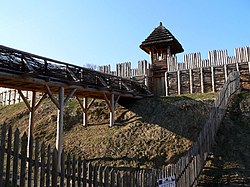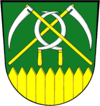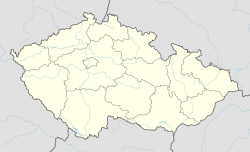Chotěbuz
|
Chotěbuz Kocobędz |
|||
|---|---|---|---|
| Village | |||

Archeopark Podobora
|
|||
|
|||
| Location in the Czech Republic | |||
| Coordinates: 49°46′10″N 18°35′10″E / 49.76944°N 18.58611°E | |||
| Country | Czech Republic | ||
| Region | Moravian-Silesian | ||
| District | Karviná | ||
| First mentioned | 1229 | ||
| Government | |||
| • Mayor | Martin Pinkas | ||
| Area | |||
| • Total | 10.61 km2 (4.10 sq mi) | ||
| Elevation | 330 m (1,080 ft) | ||
| Population (2006) | |||
| • Total | 1,088 | ||
| • Density | 100/km2 (270/sq mi) | ||
| Postal code | 735 61 | ||
| Website | http://www.chotebuz.cz/ | ||
![]() Chotěbuz (Polish: Kocobędz , German: Kotzobendz) is a village in Karviná District, Moravian-Silesian Region of the Czech Republic. It lies on the border with Poland, on the left bank of the Olza River, in the historical region of Cieszyn Silesia. It has 1,033 inhabitants (2001 census), 21.3% of the population are the Poles.
Chotěbuz (Polish: Kocobędz , German: Kotzobendz) is a village in Karviná District, Moravian-Silesian Region of the Czech Republic. It lies on the border with Poland, on the left bank of the Olza River, in the historical region of Cieszyn Silesia. It has 1,033 inhabitants (2001 census), 21.3% of the population are the Poles.
The name of the village is derived from an old Slavic personal name Chociebąd (Kocobąd, as the beginning Ch was often transformed into K).
The village is one of the oldest in Cieszyn Silesia. There was a fortified settlement (gród) of the Golensizi tribe in this place called Cieszynisko (or Old Cieszyn). It was an important center since the 8th century. After decline of the settlement at the beginning of the 12th century, it was relocated to Wzgórze Zamkowe (castle hill) in Cieszyn. Near the old place a new settlement was created, Podobora. It is today an archaeological site and was partly rebuilt to form archeopark which is possible to visit.
...
Wikipedia



